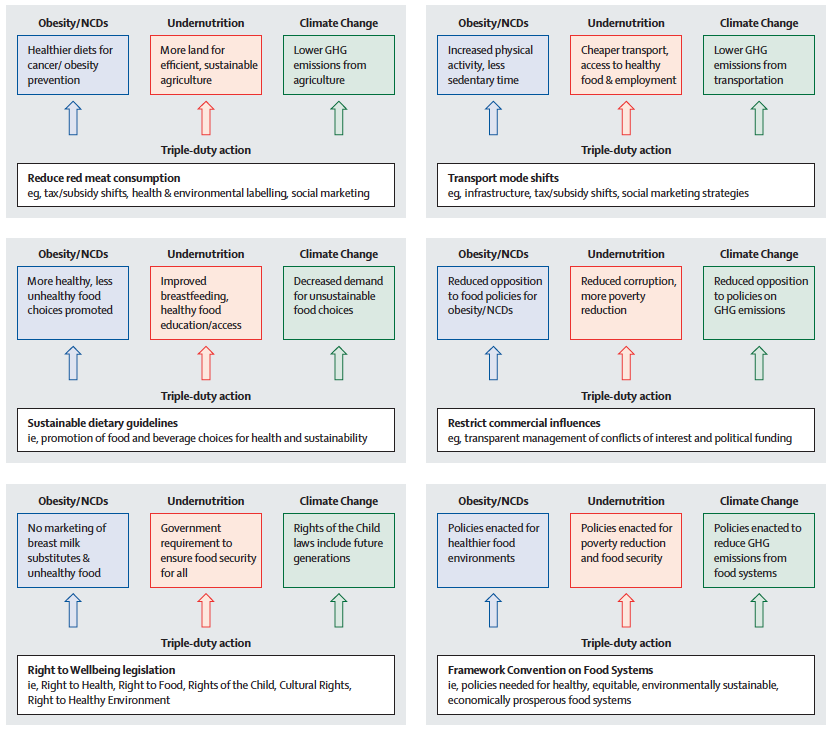2019 was an interesting year in the food and nutrition space.
The Lancet had food on its mind this year with THREE Commissions/Series:
Food in the Anthropocene: the EAT–Lancet Commission on healthy diets from sustainable food systems
The Global Syndemic of Obesity, Undernutrition, and Climate Change: The Lancet Commission report
The EAT-Lancet Commission made the biggest “footprint” and spurred much debate and controversy, and pissed some people off. Good. That is exactly what it was meant to do. This along with the Syndemic made the Altmetrics top 100 papers of 2019. Cool.
The Global Burden of Disease finally published a solo paper on diets as a risk factor. That too made the Altmetrics top 100 list.
A slew of other reports on food, planet, and people came out this year. See the image below which doesn’t capture everything. They all pretty much say the same thing: We need to transform our food system if we want to save ourselves and the planet that we live on. We cannot disentangle the two. We depend on each other. It won’t be easy. The stakes are high and so are the challenges (like urban and population pressure). It will take significant, synergistic political will and investment. We are running out of time. That is the gist.
The Global Nutrition Report and Scaling Up Nutrition (SUN) movement churned on to keep the momentum, largely in the undernutrition space, moving.
We saw some neglected areas get more attention this year. Fish, plant-based burgers, older children and adolescents. The Nobel Prize went to two stellar development economists whose research has informed our thinking on poverty, and how we can reduce it. But of course, with a dose of caution.
The Committee on Food Security is in the process of crafting the Voluntary Guidelines on Food Systems and Nutrition. Regional consultations took place all year, and a draft is now out for review. If you are interested in providing written feedback on Draft One, you can do so by sending comments to cfs@fao.org by February 5, 2020. You can find all the info here.
This was the year of reports. Let’s make 2020 the year of action. We have a lot of evidence of what to do and how to do it. Many of us have written about it in ways in an attempt to get the attention of politicians. Now, we need to take what is written on paper and translate that into changes that matter for people. We need to vote for policymakers that care about these issues at the local level. Let’s push to make food, climate, and health a part of their campaigns, and give them the opportunity to take ownership of the issues.
We also need to think about politics outside our hometowns. We have seen some major shifts in the global political machinery of how we relate to each other and our willingness to participate as global citizens. Some of the heavy hitters, such as the U.S., will continue on its downward spiral into irrelevance, with the UK following close behind. But until they completely make themselves obsolete, their decisions, unfortunately, matter for the world, as we witnessed with the shoulder-shrugging at the COP 25 negotiations in Spain. Another year, lost.
But I am a cautious optimist. Well…let’s not push our luck here. Maybe more of a realist. We have the Tokyo 2020 moment to increase investments for nutrition (which are currently dismal). We will be half-way through the UN Decade of Action on Nutrition and 1/3 through the Sustainable Development Goals (not sure what this means, but hey). Derek Byerlee and I wrote about how far we have come and what achieving SDG2 means for the world. We have the Committee on Food Security hopefully approving the Voluntary Guidelines mentioned above. And we always have COP 26, to stir up a miracle to save the planet. These global moments are important, but not enough.
This is what I plan to do in 2020:
I am going to take a look in my own backyard to make changes (and maybe stop flying around the world, thinking I am saving it).
I will vote with my fork and the dire importance of the 2020 election in the U.S. cannot be understated.
I will work more with people and less with paper – i.e. stop being involved in all these goddamn reports (that few read…).



